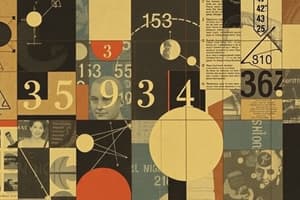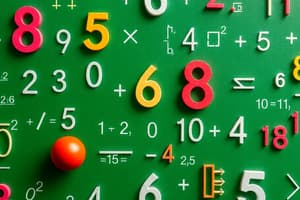Podcast
Questions and Answers
What represents the instantaneous rate of change in a function?
What represents the instantaneous rate of change in a function?
- Linear approximation
- Integral
- Average rate of change
- Derivative (correct)
Which measure of central tendency is least affected by outliers?
Which measure of central tendency is least affected by outliers?
- Median (correct)
- Variance
- Mean
- Mode
What is the primary purpose of a probability distribution?
What is the primary purpose of a probability distribution?
- To calculate averages
- To visualize data points
- To identify mode in data sets
- To describe the probability of different outcomes (correct)
Which type of reasoning moves from specific observations to general conclusions?
Which type of reasoning moves from specific observations to general conclusions?
In the context of set theory, which operation is used to find elements common to two sets?
In the context of set theory, which operation is used to find elements common to two sets?
Which of the following types of numbers includes negative values?
Which of the following types of numbers includes negative values?
What is the correct order of operations in mathematics known as?
What is the correct order of operations in mathematics known as?
Which number type can be represented as a fraction of two integers?
Which number type can be represented as a fraction of two integers?
What type of equations involve multiple equations with multiple variables?
What type of equations involve multiple equations with multiple variables?
Which of the following shapes is not a polygon?
Which of the following shapes is not a polygon?
In the expression (2^3), what does the '3' signify?
In the expression (2^3), what does the '3' signify?
Which branch of mathematics deals with the study of limits and functions?
Which branch of mathematics deals with the study of limits and functions?
What mathematical concept is used for finding the difference between two quantities?
What mathematical concept is used for finding the difference between two quantities?
Flashcards
Derivative
Derivative
The rate at which a function's output changes at a specific point.
Integral
Integral
Finding the area under a curve between two points, essentially calculating the total amount accumulated over a specific interval.
Mean
Mean
The average value of a set of data. It is calculated by adding all values and dividing by the total number of values.
Logic
Logic
Signup and view all the flashcards
Standard deviation
Standard deviation
Signup and view all the flashcards
What is mathematics?
What is mathematics?
Signup and view all the flashcards
What are rational numbers?
What are rational numbers?
Signup and view all the flashcards
What are real numbers?
What are real numbers?
Signup and view all the flashcards
What is addition?
What is addition?
Signup and view all the flashcards
What are equations?
What are equations?
Signup and view all the flashcards
What is geometry?
What is geometry?
Signup and view all the flashcards
What is a limit in calculus?
What is a limit in calculus?
Signup and view all the flashcards
What is Euclidean geometry?
What is Euclidean geometry?
Signup and view all the flashcards
Study Notes
Fundamental Concepts
- Mathematics is a formal system of logic and reasoning used to quantify, order, and understand the world.
- It encompasses various branches, including arithmetic, algebra, calculus, geometry, and more.
- Key mathematical tools include numbers, symbols, and operations.
- Mathematics is crucial for problem-solving in diverse fields, from science and engineering to finance and economics.
- Mathematical concepts are often presented in a structured and abstract language.
Number Systems
- Natural numbers (counting numbers): 1, 2, 3, ...
- Whole numbers: 0, 1, 2, 3, ...
- Integers: ..., -3, -2, -1, 0, 1, 2, 3, ...
- Rational numbers: numbers that can be expressed as a fraction p/q where p and q are integers and q is not zero.
- Irrational numbers: numbers that cannot be expressed as a fraction of two integers. Examples include pi (π) and the square root of 2 (√2).
- Real numbers: the set of all rational and irrational numbers.
- Imaginary numbers: numbers whose square is negative. Expressed as multiples of i where i² = -1.
- Complex numbers: the union of real and imaginary numbers in the form a + bi, where a and b are real numbers.
Arithmetic Operations
- Addition (+): Combining quantities.
- Subtraction (-): Finding the difference between quantities.
- Multiplication (× or *): Repeated addition.
- Division (÷ or /): Repeated subtraction or finding a quotient.
- Exponentiation (^): Repeated multiplication (e.g., 2^3 = 2 × 2 × 2).
- Order of operations (PEMDAS/BODMAS): a set of rules for evaluating expressions with multiple operations.
Algebra
- Variables: Symbols representing unknown values.
- Equations: Statements of equality between expressions.
- Solving equations: Finding the value(s) of the variable(s) that satisfy the equation.
- Inequalities: Statements comparing quantities using symbols like <, >, ≤, ≥.
- Polynomials: Expressions involving variables and coefficients.
- Factoring: Breaking down an expression into simpler expressions.
- Systems of equations: Multiple equations with multiple variables.
Geometry
- Shapes and their properties: Lines, angles, triangles, quadrilaterals, circles, and more.
- Measurement: Calculating lengths, areas, and volumes.
- Transformations: Translations, rotations, and reflections of shapes.
- Coordinate geometry: Using coordinates to locate points on a plane.
- Euclidean geometry: The study of geometry based on Euclid's postulates.
Calculus
- Limits: Approaching values of a function.
- Derivatives: instantaneous rate of change.
- Integrals: finding the area under a curve.
- Applications: Solving problems involving motion, growth, and optimization.
Statistics and Probability
- Data collection and analysis.
- Measures of central tendency (mean, median, mode).
- Measures of dispersion (variance, standard deviation).
- Data visualization (graphs, charts).
- Probability: Calculating the likelihood of events.
- Probability distributions: describing the probability of outcomes.
Logic and Reasoning
- Deductive reasoning: Moving from general truths to specific conclusions.
- Inductive reasoning: Moving from specific observations to general conclusions.
- Proof techniques: Strategies for validating mathematical statements.
- Sets and logic: Defining sets and relationships within sets, fundamental principles of logical deduction.
Studying That Suits You
Use AI to generate personalized quizzes and flashcards to suit your learning preferences.




